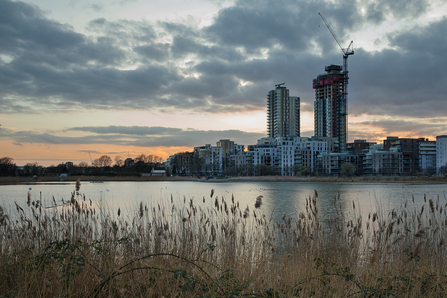Woodberry Wetlands is a stunning wildlife oasis in Stoke Newington, east London. It spans 11 hectares, the equivalent of 13 football pitches. The focus of this haven is a reservoir which was built in 1833 but has been closed to the public ever since. It is surrounded by Woodberry Down’s dense mix of social housing estates, new development and Victorian terraces. The reserve is already attracting a new breed of young, urban, conservation volunteer.
From 1955-1980 chlorine and sodium phosphate gas were pumped into the reservoir to disinfect the water, preventing almost all wildlife from living there. Once this practice stopped, nature began to thrive, attracting species rarely seen so far into London. Six years ago, London Wildlife Trust began plans to make a new public nature reserve with the support of private and public sectors. London Wildlife Trust has now created over 13,000m2 of reedbed and planted 550m2 of hedgerow, wildflower meadows and fruit trees to attract birds, bees, butterflies and other insects. This cutting-edge wetland with its tower-block backdrop can now become an attraction for people too.
Just 20 minutes from Leicester Square in the centre of London, Woodberry Wetlands will open its doors to the public on Sunday 1 May 2016.
Woodberry Wetlands is the inspirational outcome of years of dedicated effort and a great partnership with Thames Water
Background
Originally built as storage for drinking water in the 19th century, the reservoir became recognised for its value to wildlife and was designated a Site of Metropolitan Importance for Nature Conservation in 1987. In 2007 London Wildlife Trust started a community garden in a closed corner and began to convert the reservoir into a nature reserve in 2010 with partners including landowner Thames Water. The conservation of both the built and natural heritage is central to this project: it aims to bring people closer to nature as well as to fulfil a vision for a greener London.
Woodberry Wetlands has some important historic buildings which were in urgent need of repair. Placed on Historic England’s Heritage at Risk Register, the Grade II listed Coal House, a former coal store and kitchen, has been completely restored and will be open for the public to enjoy as a visitor centre and café. A smaller Grade II structure, the Ivy Sluice House also stands on the site.
Stephanie Hilborne OBE, The Wildlife Trusts’ chief executive, says: “The Wildlife Trusts care for over 2,000 wild havens around the UK - refuges for wildlife until our wider countryside and cities become more hospitable to the animals and plants with which we share the world. These are natural places that people can enjoy day after day - and in urban areas they are particularly valuable as wild oases where people can switch off, be soothed by the rustle of wind blowing through reeds or be thrilled by the sight of a kingfisher. Woodberry Wetlands is the inspirational outcome of years of dedicated effort and a great partnership with Thames Water.”
Gordon Scorer, London Wildlife Trust’s chief executive, says: “Access to nature is incredibly important for people’s wellbeing, especially in built-up cities and towns. The rebirth of this reservoir, in the midst of one of London’s biggest housing regeneration projects, as a free-to-visit, natural resource, bringing nature within reach of a huge urban audience, demonstrates that nature, and all its benefits, can be successfully weaved into the fabric of London, and other cities, as they develop and grow.”
Richard Aylard, Thames Water sustainability director, says: “Our reservoirs play a vital role in supplying drinking water to millions of customers and it’s wonderful that they can do this while also providing a haven for wildlife and a place for local people to enjoy the great outdoors, close to the heart of London. We’re proud to be working in partnership with the London Wildlife Trust on the Woodberry Wetlands project which we feel sure will benefit the health and wellbeing, and quality of life, of all those who visit this very special site.”

